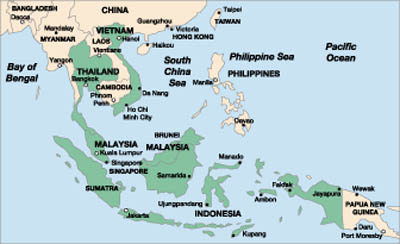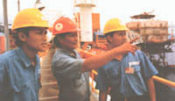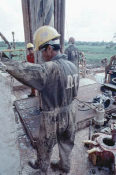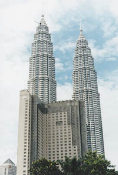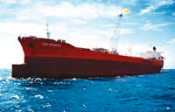Upstream activity set to rebound in Southeast Asia
SPECIAL REPORT: SOUTHEAST ASIAUpstream activity set to rebound in Southeast AsiaThis first article of a seven-part series on Southeast Asia provides an overview of several major players in the region, examining recent activity trends and finding that most of these countries are poised for renewed growthKurt S. Abraham, International Editor
This article describes what has occurred in the up-stream sectors of four countries during the past two years and what the prospects are for improved performance in the near future. Regionwide, industry executives seem to agree that several factors need to improve, in order for Southeast Asia to mount a full recovery. These include a rebound by the region’s natural gas market, which is going to need more time than the oil sector to sort itself out; a reduction in the massive oversupply of seismic data worldwide; and people reestablishing their "hunches" about various oil prospects. Already, there are some changes in the market that should push gas demand higher.
Observers also point out that throughout the greater Far East, Japan’s economy is at least as big as all the other economies, including Australia’s, put together. So if a 1%-to-3% increase occurs in Japan’s economy, it can have an enormous effect on energy usage by the entire Far East. For instance, if Japan is recovering – knowing that the rest of the economies are going to be pulled through – that alone will translate to many additional LNG cargoes. So, the feeling among many industry leaders is that once Japan recovers, the Southeast Asian countries will follow suit, and there could be 6%-to-7% growth, once again, in the region within three to five years. This is why many operators remain bullish about the region, taken as a complete picture.
Amid numerous riots and demonstrations in the capital city, Jakarta, the Indonesian parliament selected the country’s new president and vice president during mid-October 1999. Just two weeks later, the view around town showed an eerie calm and a sense of "business as usual" had been restored. Even now, Indonesians seem exhausted by the turmoil of the mid-1998-to-late-1999 period – they look forward to a period of relative tranquility under new President Abdurrahman Wahid and Vice President Megawati Sukarnoputri. There is a sense that it is time to get on with business. Parliament’s election of Wahid and Megawati cooled inflamed passions that spread among citizens during last October. Megawati originally was a presidential contender, but her enraged supporters quickly ended their riot- spawning demonstrations in Jakarta after she was elected vice president. Now, all the political parties / factions seem to be sufficiently mollified by this arrangement. More important, the Wahid / Megawati team appears to be making good decisions, both politically and economically. This is good news for an E&P industry that has been nervous ever since former strongman Soeharto was forced to resign the presidency in May 1998. After drilling 991 wells in 1997 and 1,015 in 1998, Pertamina and the foreign oil companies are on a trend to drill about 970 wells in 1999. This will be the lowest total since 1996, but it certainly is not the major decline registered in other parts of the world. Early prognosis for 2000 is that drilling will improve toward 1998’s level. Pertamina said it expects capital investment for E&P to rebound next year. Spending on projects fell 9.2% to $5.56 billion in 1999, from $6.12 billion in 1998. Ironically, government officials said last October, that the country will have to import more oil products this year if its economy recovers, as domestic supplies cannot meet increased demand. "Imports of oil products will increase when Indonesia’s economy improves," said one official. "The imports will be mainly diesel oil." Supervision of Indonesia’s upstream sector is handled by state oil company Pertamina. When onshore and offshore activity are considered together, Indonesia’s largest foreign operator is Caltex, the Chevron / Texaco joint venture. However, the largest operator in strictly offshore projects is Total Fina, followed by Maxus / YPF, Unocal and ARCO (soon to be part of BP Amoco). Onshore, Caltex rules the sector, followed by VICO and Exspan. Pertamina itself produces about 50,000 bopd from onshore fields it operates.
If there is one item that Pertamina wants more than anything else, it is a new oil and gas law, said the company’s Senior Vice President and Director of E&P, Dr. Priyambodo Mulyosudirjo. "We really need to have a new law, because the current one does not help Pertamina (or the foreign operators) expand its activities. We need it, to give us more flexibility. The problem at present is with the content of specific portions of the old law." Indonesian officials have concluded that the chances of finding any additional giant fields, particularly oil, are about nil for the western half of the country. However, now that the West is mature, they hope to make some giant finds in the East. Pertamina has tried to push operators to focus more on the East, although some companies have balked at what they consider too much risk under terms of the existing oil and gas law. Nevertheless, notes Dr. R.S. Trijana Kartoatmodjo, who services the foreign PSCs, Pertamina expects to build on recent successes by independent operators in the East. "Hopefully, it will have a multiplier effect." Indonesia has been able to hold its crude and condensate output at a level of 1.5 million to 1.6 million bpd during the last two years. Even so, there is a growing realization among officials and companies that the country is really more of a gas province that just happens to have a large amount of oil. Gas output averaged 7.2 to 7.3 Bcfd during 1997 and 1998. Not surprisingly, natural gas is playing an increasingly larger role in field development plans. Of nine fields that went onstream in 1998, the vast majority were gas deposits. As compiled by Wood Mackenzie, there are another 15 Indonesian fields either under development or likely to be developed. Of these, nine are gas fields, some of which contain moderate amounts of oil or condensate. Conoco is developing several gas fields in the West Natuna area, to fulfill a deal signed with Sembawang Gas during the last year to supply an initial 325 MMcfgd to Singapore and Malaysia by July 2001. Construction of a new, $135-million, purpose-built production jackup begins in January, as does the laying of a 300-mi, $400-million pipeline from the West Natuna fields to Singapore.
This constitutional monarchy is one of Asia’s most stable countries. Prime Minister Chuan Leekpai first served in his position from May 1992 to May 1995 as head of the Democratic Party. In November 1997, he regained the PM position as head of a coalition that retains power today. Chuan’s return as PM was triggered by the Asian financial crisis, which began when Thailand floated its currency, the baht, in July 1997. After 10 years of 9.4% average annual growth ending in 1996, the Thai economy shrank 9.4% in 1998. The U.S. State Department predicts modest recovery for 1999, to be followed by greater growth in 2000. Supervision of the upstream industry in Thailand is the responsibility of the Department of Mineral Resources. In turn, government participation in actual E&P operations is carried out by state firm PTTEP. Government ownership of PTTEP has been reduced to about 61%, after a sale of shares to investors was conducted in 1998. PTTEP reached a significant milestone during July 1998, when the company took over operatorship of the Bongkot gas field development from Total Exploration and Production Thailand. The dominant operator remains Unocal, which has been in Thailand for 37 years. The firm operates 13 producing fields, containing 90 platforms and about 1,300 wells. Unocal accounts for 1.0 Bcfgd of Thailand’s total 1.8 Bcfgd. After handing off Bongkot to PTTEP, Total has a reduced profile. The company continues to provide services and staff, however, to Bongkot’s new operator through a technical assistance contract. In central onshore Thailand, Shell retains a significant presence via the Sirikit concession, west of Phitsanulok. Several other companies are conducting minor exploration programs.
Perhaps the biggest news is the entry of Chevron into Thailand as a bonafide competitor to Unocal. Chevron entered the country in December 1998 by purchasing Rutherford Moran Oil Corp. Chevron assumed Rutherford Moran’s share of the B8-32 offshore concession and took over operatorship from Pogo Producing Co. Chevron put a second gas / condensate field, Benchamas / Pakarong, onstream during July 1999 in the B8-32 offshore tract. Initial development plans are being drawn already for two additional fields in B8-32. Chevron also is considering acquisition of additional tracts that would make the firm a serious challenger to Unocal’s dominance. The E&P industry in this gas-prone country outperformed the overall economy in 1998, with wells drilled rising 16%, from 192 in 1997. For 1999, the final count should be close to 1998’s figure. Activity in 1998 was boosted by Unocal’s development of Pailin gas field (five platforms installed and 45 wells drilled, due to difficult geology). Pailin was brought onstream in third-quarter 1999. Elsewhere, Unocal pursues a steady "just in time" strategy for developing additional gas fields. Several candidates for development have been identified, and the company will pursue these as market forces permit. Meanwhile, state firm PTTEP continues to expand development of Bongkot gas field. Phase III-A expansion was completed during 1998 and encompassed installation of two additional wellhead platforms and a third gas processing train. Phase III-B expansion is underway, involving the installation of two wellhead platforms, No. 11 and No. 12, and the drilling of additional development wells. The Phase III-C and D portions will follow and include two more platforms to maintain plateau production at 550 MMcfgd. Thailand’s crude and condensate output reached 75,560 bpd in 1998, up about 6% from 1997’s level. Gas production also increased 6% in 1998, to 1.7 Bcfd. For 1999, preliminary figures indicate that similar percentage increases were achieved for both commodities. According to analysts at Wood Mackenzie, the new field development projects most likely to proceed in the near term are Chevron’s Maliwan gas / condensate field in the B8-32 tract, and Unocal’s Pakarang and South Gomin gas / condensate fields in the 3rd Contract Area. Chevron reportedly would put Maliwan onstream in 2005. Unocal’s plan calls for starting up Pakarang and South Gomin in 2003 and 2005, respectively.
In various incarnations, the dominant 14-party coalition known as Barisan Nasional has controlled Malaysia’s government since the nation gained independence in 1957. In the last general election in 1995, Barisan Nasional won an overwhelming majority – 162 out of 192 parliamentary seats. After a decade of strong economic growth that averaged 8.7% annually, Malaysia was hit hard by the Asian crisis. However, a recovery is underway. The economy should show minor growth in 1999 after shrinking 7.3% during 1998. State firm Petronas (through its operating arm, Petronas-Carigali) and Esso Malaysia (Exxon) dominate an E&P sector that has been stable despite see-sawing oil prices. On average, six rigs drill 70 to 80 wells annually. There are three areas of principal activity: offshore Peninsular Malaysia, and offshore Sarawak and Sabah states on the northwest side of Kalimantan Island. Separately, additional work is done in the Malaysia-Thailand Joint Development Area (MTJDA), offshore in the Gulf of Thailand.
Despite the dominance of Petronas and Esso, several other operators are involved in Malaysia. In fact, three new operators – Amerada Hess, Santa Fe Snyder and YPF – entered this market in 1998 by signing new PSCs (production sharing contracts). This had been the goal of Petronas when, in the mid-1990s, the company devised a flexible PSC, to attract more investors to small fields. The firm also loosened terms for all PSCs in 1997. In January 1999, Murphy Oil signed for three PSCs as operator. Petronas-Carigali and the foreign operators face a significant challenge in their goal to keep Malaysian oil output up, to a range of 600,000 to 630,000 bpd. This will require them to find substantial new reserves, yet recent experience shows that the majority of new reserves are coming from incremental growth in existing fields, while oil discoveries are trending smaller and smaller. The best exploration prospects for finding incremental reserves of crude are near, or adjacent to, existing fields, where additional small pockets of oil are situated. Deepwater areas are also considered high on the list of prospectivity. Petronas acknowledges that, with improved seismic techniques, it can now look at deeper horizons, as well as identify high-pressure horizons in shallower waters. A number of development projects at small oil fields are underway offshore. After putting Yong and Raya fields onstream, Esso is developing Larut field on its PM5 Block, and similar work is progressing on Shell’s F 23 SW satellite and Asam Paya field, straddling the Malay / Brunei border. Another 10 or more oil and gas fields are considered probable for development, with onstream dates ranging from 2001 to 2005. Petronas-Carigali’s strategy, as mentioned earlier, is to keep oil output from slipping below 600,000 bpd, so new projects are geared to that goal. Officials are not happy with a 36% average oil recovery rate, so they hope to utilize new technologies to boost that figure. If improvement can be achieved, Petronas officials say they are not greedy – they do not expect to improve to 50%, but a gain to 40% or 41% is something they believe is doable. It also is cheaper, they point out, than drilling to find new discoveries. Convinced that technology will permit them to do what was not feasible 10 years ago, Petronas officials say they will go back to many older wells and see what kind of measures can be applied to squeeze out additional reserves. Natural gas is playing a larger role. Reasons include expanding industrial usage, gas discoveries outnumbering oil finds and new oil pockets becoming smaller. Gas output was about 4.7 Bcfd during 1997 and 1998. Petronas would like to begin drilling for gas in deepwater areas, too, but that program was delayed until the effects of low oil prices in 1998 and early 1999 have passed. Petronas also is heavily involved in "CORAL" (Cost Reduction Alliance), the Southeast Asian counterpart to the UK’s CRINE initiative. The programs share a common goal, to reduce average finding, development and production costs. Petronas has taken the lead on CORAL. The company is using 1995 as a cost base and has calculated that it can reduce average development and production costs by 30% by later this year. Additionally, the firm is trying to reduce its development cycle time by 30%. Petronas stresses that all companies active in the country can discuss common standardization, optimization, etc. If any of them come up with a good cost- or time-saving idea, then the state firm will listen and most likely adopt it.
The current constitution, approved in April 1992, restructured the government while reaffirming the role of the Communist Party of Viet Nam as the leading influence of state and society. The Party is required to operate within the constitutional framework and laws of the country, and it is no longer allowed to direct day-to-day operation of the government. The National Assembly was granted an increase in its power and independence. The collective Council of State, which had served as the parliament’s standing committee and whose chairman acted as ceremonial head of state, was abolished. It was replaced by an office of the President, with administrative powers, supervision of the armed forces and the power to recommend dismissal of government officials, subject to approval of the National Assembly. The revised constitution also replaced the cumbersome Council of Ministers with a cabinet headed by the Prime Minister. In Viet Nam, governmental policy is largely the prerogative of the communist leadership, with policy being set by the Politburo and its five-man Standing Board, which oversees day-to-day policy implementation. Viet Nam faces challenges from the Far Eastern economic crisis and a falling growth rate, as the impact of earlier reforms fades. Structural reforms decreased during the past two years, and investors are concerned about reversal of policy reforms and a lack of governmental clarity. Among the serious problems that the Vietnamese government faces are its high current account deficit, a fairly high level of external indebtedness (at 23% of GDP in 1997), and rising levels of non-performing bank loans. Responsibility for Vietnamese E&P affairs remains the province of state oil company Petrovietnam. In recent years, foreign operators were eager to enter Viet Nam and invest. Unfortunately, they often found that once they became involved, the pace of progress could be agonizingly slow. Eventually, when the regulatory system failed to pick up speed, some of these firms lost interest. In 1998, the government appeared to realize the combined consequences of its slow action and the regional economic recession. Operators reported that officials were adopting a more conciliatory approach. In addition, Petrovietnam in November 1998 introduced new fiscal incentives for deepwater and remote areas, or areas with special geographical, geological, economic and technical problems. Companies operating in Viet Nam include the Russian / Vietnamese JV, Vietsovpetro; Petronas-Carigali; JVPC; BP Amoco and several others that are focusing mostly on exploration, such as Unocal and Anzoil. However, Unocal does have a gas discovery, where more drilling will follow this year. Two offshore PSCs were awarded in 1998, to Unocal and Conoco, and an additional tract was granted to Unocal in October 1999. Unocal’s acreage is adjacent to its Thai tracts. In addition, Petrovietnam last year exercised its right to take 15% of a license operated by BP Amoco, while Teikoku Oil and AEDC dropped out of a tract now held equally by BP Amoco and Statoil. Exploration dropped off dramatically during the 1996-1998 period. After drilling 27 exploratory wells in 1996, foreign operators drilled only half that amount in 1997, and the total dropped to only four wells in 1998. Early data indicate that a number similar to 1998’s level was recorded last year. However, a moderate rebound is expected during 2000, based on greater amounts of seismic shot during 1998 and 1999, as well as new PSCs issued and existing drilling commitments. Overall, drilling has declined since 1996, although not as drastically during the last year as in some other countries. From 57 wells in 1996, the total shrank to 40 in 1997 and 37 in 1998. An early estimate for 1999 is perhaps 35 to 37 wells, signaling a bottoming out of activity. A slight increase is anticipated for 2000, to 40 or 41 wells. Compared to its neighbors, Viet Nam is unique, because its fields produce from sandstone and basement formations. A prime example is the country’s largest oil field, Bach Ho (White Tiger), where 90% of output comes from the basement. Viet Nam produced 245,745 bopd in 1998, up 26% from 1997’s 195,000-bopd level. Crude output comes from five fields – -Bach Ho, Rong, Ruby, Rang Dong and Dai Hung.
BP Amoco’s Lan Tay / Lan Do complex offshore is the only new field development project likely to proceed in the near term. Discovered in 1993, these fields contain 2 Tcf of natural gas and 13 million bbl of liquids. As currently envisioned, development would include a wellhead platform in about 500 ft of water, with first output in 2002. Further gas development will hinge on the success of this project and how strong the growth in Viet Nam’s electrical power demand becomes. Investment for additional new oil field developments depends on the success of current projects at Ruby and Rang Dong fields. Both of these came onstream during 1998, utilizing early production systems. Incremental expansion into full field development of Ruby and Rang Dong should take place over the next five years. At Ruby, plans are underway to move the field beyond the
pilot phase. There will be further in-field drilling, as well as development of the field’s
gas resources. While condensate and additional oil will continue to be routed through the
Ruby FPSO, gas output will be piped directly to onshore facilities. Petronas-Carigali is
working to finalize plans for these facilities with Petrovietnam.
Copyright © 2000 World
Oil |
- Applying ultra-deep LWD resistivity technology successfully in a SAGD operation (May 2019)
- Adoption of wireless intelligent completions advances (May 2019)
- Majors double down as takeaway crunch eases (April 2019)
- What’s new in well logging and formation evaluation (April 2019)
- Qualification of a 20,000-psi subsea BOP: A collaborative approach (February 2019)
- ConocoPhillips’ Greg Leveille sees rapid trajectory of technical advancement continuing (February 2019)

